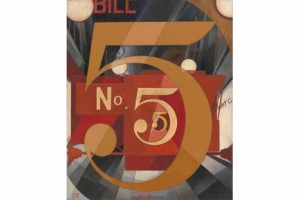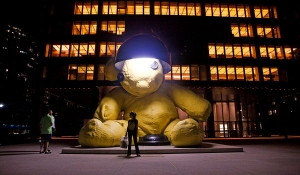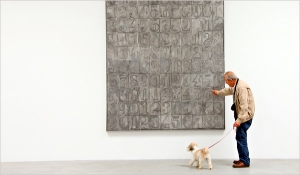|
Displaying items by tag: NY

Exhibition Dates: October 13, 2011 – January 2, 2012
For more than 60 years, the Alfred Stieglitz Collection has been the cornerstone of The Metropolitan Museum of Art’s holdings of modern art from the first half of the 20th century. From October 13, 2011, through January 2, 2012, the Museum will present Stieglitz and His Artists: Matisse to O’Keeffe, the first large-scale exhibition of paintings, sculptures, drawings, and prints from Stieglitz’s personal collection, acquired by the Metropolitan in 1949. The exhibition will feature some 200 works by major European and American modernists, including Georgia O’Keeffe, Pablo Picasso, Henri Matisse, Constantin Brancusi, Vasily Kandinsky, Francis Picabia, Gino Severini, Marsden Hartley, John Marin, Charles Demuth, and Arthur Dove.
The exhibition is made possible by the Iris & B. Gerald Cantor Foundation.
In addition to being a master photographer, Alfred Stieglitz (1864-1946) was a visionary promoter of modern American and European art, and he assembled a vast art collection of exceptional breadth and depth. Through a succession of influential galleries that he ran in New York City between 1905 and 1946, Stieglitz exhibited many of the most important artists of the era and collected hundreds of works of art by his contemporaries.
This will be the first time since their acquisition in 1949 that the Museum’s vast holdings from the Stieglitz Collection—including many works on paper that are rarely on view—will be exhibited together.
Alfred Stieglitz played a pivotal role in the introduction of modern art into America and its subsequent development over the course of the first half of the 20th century. At his Little Galleries of the Photo-Secession (1905-17), known as ‘291,’ Stieglitz boldly showed the work of avant-garde European artists such as Auguste Rodin, Picasso, Matisse, Picabia, Brancusi, and Severini—sometimes before it was shown anywhere else in the United States. The first rooms of the exhibition Stieglitz and His Artists: Matisse to O’Keeffe will focus primarily on works by European artists. Among the highlights are: Picasso’s Woman Ironing (1901) and Standing Female Nude (1910), Kandinsky’s Improvisation 27 (Garden of Love II) (1912), and Brancusi’s Sleeping Muse (1910), as well as a suite of prints by Henri de Toulouse-Lautrec (1890s). The first half of the exhibition also includes a room of drawings by the Mexican caricaturist Marius de Zayas, who was a pivotal advisor to Stieglitz and played a major role in organizing some of the most avant-garde exhibitions at 291 in the 1910s.
In Stieglitz’s subsequent undertakings, first in borrowed space at the Anderson Galleries (1921-25) and later at his own galleries—the Intimate Gallery (1925-29) and An American Place (1929-46)—he refocused his energy on showing and supporting contemporary American art, which was not well represented in prestigious public and private collections at the time. The latter portion of the exhibition Stieglitz and His Artists will feature works by American painters whose careers he shepherded from the 1920s to 1946 and whose work he felt epitomized the authentic American experience: Arthur Dove, John Marin, and Georgia O’Keeffe. There also will be individual rooms devoted to the works of Charles Demuth and Marsden Hartley, including Demuth’s I Saw the Figure 5 in Gold (1928), and Hartley’s Portrait of a German Officer (1914). The exhibition will culminate in a gallery of some 14 works by O’Keeffe, such as her iconic paintings Black Iris (1926) and Cow’s Skull: Red, White, and Blue (1931).
Among the other artists featured in the exhibition are: Gordon Craig, Henri Edmund Cross, Arthur B. Davies, Gaston Lachaise, Stanton Macdonald-Wright, Diego Rivera, Paul Signac, Félicien Rops, and Abraham Walkowitz.
In addition to the paintings, sculptures, drawings, and prints displayed, the exhibition will include a number of photographs by the Photo-Secessionists, as well as publications by the Stieglitz Circle, all from his personal collection.
About the Collection
After his death in 1946, Stieglitz’s wife, Georgia O’Keeffe, as executrix of his estate, decided which institutions would receive gifts of art from his collection. The Metropolitan Museum was very fortunate to receive the largest share of Stieglitz’s personal collection: more than 400 paintings, sculptures, drawings, and prints. The remaining works from his collection were distributed among the Art Institute of Chicago, Philadelphia Museum of Art, National Gallery of Art in Washington, D.C., Fisk University in Nashville, and Yale University’s Beinecke Rare Book and Manuscript Library in New Haven.
Stieglitz and His Artists: Matisse to O’Keeffe is organized by Lisa Mintz Messinger, Associate Curator in the Museum’s Department of Nineteenth-Century, Modern, and Contemporary Art.
The exhibition will be accompanied by a major scholarly catalogue of the entire collection, edited by Lisa Mintz Messinger, with contributions by 11 Metropolitan Museum curators, researchers, and conservators. The catalogue will feature 440 full-color illustrations, an introductory essay, individual essays on the artists, and entries on all 409 paintings, sculptures, drawings, and prints from the Alfred Stieglitz Collection at the Metropolitan. Published by The Metropolitan Museum of Art and Yale University Press, the catalogue will be available for sale in the Met’s book shops ($65, hardcover).
The Museum will offer an array of education programs for this exhibition, including subscription lectures, a Sunday at the Met program, gallery talks, films, and services for visitors with disabilities.
An audio tour, part of the Museum’s Audio Guide Program, will be available for rental ($7, $6 for Members, $5 for children under 12).
The Audio Guide is sponsored by Bloomberg.
Stieglitz and His Artists will be complemented by the presentation of Photographic Treasures from the Collection of Alfred Stieglitz in the Museum’s Howard Gilman Gallery from October 13, 2011, through February 26, 2012. This installation will feature 45 masterpieces from Stieglitz’s collection of photography, including rarely seen works from the turn of the 20th century by Anne Brigman, Alvin Langdon Coburn, F. Holland Day, Gertrude Käsebier, Joseph Keiley, Heinrich Kühn, Edward Steichen, Clarence White, and others.
Stieglitz and His Artists also will be featured on the Museum’s website at www.metmuseum.org.

It is the outdoor art season in New York and therefore a good time to ask what makes for a successful piece of urban public art. When art ventures away from the nurturing shelter of the white-walled gallery, it must contend with all kinds of distractions: huge buildings; noisy vehicular and pedestrian traffic; spectacular, sexy commercial signs with dizzying video imagery; unpredictable weather; the verdant beauty of a park; and the sheer interestingness and variety of so much else that in the artificial and natural fabric of the city.
One way for public art to distinguish itself is to be really big. This year’s prize for size should go to Jaume Plensa’s “Echo,” a gigantic, ghostly, white head of a girl in Madison Square Park. Towering 44 feet, it is made of molded fiberglass resin parts fitted together so the seams show. It looks as if it had been carved from a huge, laminated block of marble, and the girl’s features are rendered smoothly as if they had been eroded by the elements over the years. The head is also oddly distorted — flattened in such a way that it resembles a digitally manipulated three-dimensional photograph or a hologram. Viewed from a distance at night, when it is bathed in the bright light of lamps around its base, it seems to glow, a silently plaintive specter conjured, maybe, by the guilty conscience of a rapacious modernity.
Less spectacular but effectively haunting in its own way — partly because of its grand scale — is one of a number of works commissioned by the High Line: a greatly enlarged black-and-white photograph by Robert Adams mounted on a billboard next to that elevated park. Made in 1978 in rural Nebraska, the photograph shows a narrow, much weathered country road running between fields of tall grass and extending from the foreground to the top of a low, faraway hill. Dried, fallen leaves from small trees have gathered at the side of the road. A melancholy mood is enhanced by blocks of funereal black filling in the oblong expanse of the billboard on either side of the picture. Like Mr. Plensa’s sculpture the photograph evokes something neglected, a soulful road not taken. But there is too an eerie feeling of hopefulness, of a possibility not yet foreclosed. (The billboard will regularly present landscapes by eminent photographers selected by the photographer Joel Sternfeld.)
Mr. Adams’s photograph works not only because of its drive-in-movie scale but also because it is so different from the kind of visual material that normally attracts and assaults the public eye. A few yards farther up the High Line, strollers come upon another billboard: not an artwork but a huge advertisement for Larry Flynt’s Hustler Club. With its blaring purple and gold hues and the come-hither expression of the sultry woman it pictures, it must be an embarrassing thorn in the side of the High Line’s administrators, who clearly favor low-key subtlety over high-impact flash. Another expansive piece on the High Line, for example, is a long wall of windows by Spencer Finch called “The River That Flows Both Ways.” Each of hundreds of panes is the color of a pixel from a photograph of the surface of the Hudson River. Jade, wine, teal and other muted hues produce a lovely, quiet symphony of color.
An elephantine sculpture in front of the Seagram Building on Park Avenue at 53rd Street has much going for it: impressive scale, contrast with the normal environment and popularly appealing imagery. Urs Fischer’s “Untitled (Lamp/Bear)” is a 23-foot-tall representation of a lumpy yellow stuffed bear wedged into the space between the base and the shade of an old desk light. Weighing in at almost 17 tons, it is made of painted cast bronze and has table-top size button eyes sewn on with rope. The light glows at night. (Christie’s, the auction house that recently sold the sculpture, organized its outdoor presentation.)
For contemporary art followers the obvious comparisons are Jeff Koons sculptures like the giant shiny “Balloon Dog” and the flower-covered “Puppy.” But the Fischer displays little of the fanatical attention to surface and detail seen in Mr. Koons’s work. It also relates to the tradition of the Duchampian found object and the absurdist Pop Art monuments of Claes Oldenburg and Coosje van Bruggen. Leaving aside its presumptive pedigree, however, it is not very different technically and aesthetically from the kitschy, Pop-realist sculptures of J. Seward Johnson, whose enormous representation of Marilyn Monroe in her upward-billowing dress has caused much debate in Chicago since its recent installation there downtown.

It has been a while since sculpture could be dismissed as “something you bump into when you back up to look at a painting,” as Ad Reinhardt, the Abstract Expressionist painter, once said. Even before Reinhardt died, in 1967, the medium was going supernova, expanding and diversifying at an astounding pace. First it began incorporating all manner of found objects and nontraditional materials; then it lifted brilliant color from painting and achieved new levels of abstraction. Since then it has come to include installations, environments, land art, performance and all manner of spectacle.
Right now sculpture is enjoying a high-profile moment, thanks to a head-spinning assortment of solo shows in Chelsea and elsewhere. Some present recent work by living artists spanning several generations; others showcase fascinating historical material of varying vintages. There are more shows than can comfortably be encompassed here, so what follows is a selective tour.
In Chelsea work by three major figures of postwar American art — John Chamberlain, 84; Jasper Johns, 81; and Donald Judd, who died in 1994 but would now be 82 — form something of a high-end trifecta. All played pivotal if very different roles in turning sculpture away from traditional figuration and toward new relationships with found objects, materials, process, color and the viewer’s space.
Mr. Chamberlain, having recently joined the Gagosian franchise, is making a stunning debut at that gallery’s West 24th Street big-top space. (There is also a relatively scattershot, seemingly sour-grapes exhibition of his work at his former representative, the Pace Gallery, in its West 22nd Street space, but never mind).
Among the largest works he has ever made, the Chamberlain sculptures at Gagosian all incorporate his signature crushed car bodies, fashioned with tremendous compositional variety and verve, and his usual unerring color sense. Variously comical, stately, architectural and gestural, these pieces erupt from the gallery’s expansive concrete floors like unusually well-shaped mesas, turning the totality into an exhilarating indoor landscape.
Mr. Johns’s show at Matthew Marks’s West 22nd Street gallery is as quiet as Mr. Chamberlain’s is boisterous. It centers on a series of reliefs that perfectly illustrate Mr. Johns’s best-known axiom: “Take an object. Do something to it. Do something else to it.” As stated in Mr. Johns’s revealing conversation with the painter Terry Winters in the show’s catalog, these works stem from a relieflike SculptMetal grid of the numbers zero through nine that Mr. Johns made somewhat hurriedly and a bit on the cheap as a commission for Lincoln Center in 1964.
Recently he made a sturdier, more precise version from scratch, which unexpectedly yielded a wax model of the piece, in addition to the radiant aluminum final cast on view at Marks. With typical economy, he did “something else” with the wax work, creating six smaller, exquisite two-sided relief fragments in bronze, aluminum and even silver that conflate painting, sculpture and printmaking in a new way.
It takes a while to enter into the obsessive concentration that suffuses these works, with their shifting textures, newsprint scraps and other small objects, all embalmed in cast metal. Their combination of lapidary detail and casual process reveals the intensity of Mr. Johns’s mind with unusual clarity.
Important museum pieces will be protected under rules adopted by the New York state Board of Regents.
The Regents approved new rules that would restrict the sale of museum pieces as facilities face continued hard fiscal times.
The rules would require proceeds from sales to be used for acquisitions and would also seek to keep museum relics and pieces in the public domain even if a museum shuts down.
Former Assemblyman Richard Brodsky of Westchester says the rules will prohibit important cultural pieces being sold to private collectors in order to pay for operating expenses.
Brodsky, now a fellow at Wagner College on Staten Island, calls this an extraordinary moment in New York's cultural history.
Brodsky and the Legislature have sought the protections since the recession cut into museums' revenues.
—Copyright 2011 Associated Press
|
|
|
|
|